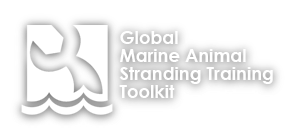Tips for starting a network
A functioning stranding network consists of the following:
- Permissions and authorizations from authorities
- Trained personnel including volunteers
- Communication capability
- Equipment (safety, response, etc.)
- Funding and sustainability plan
- Organizational structure
.
- Start small. Establish a network in a small area of coastline, replicate the model and expand to other areas.
- Convene a group of individuals or organizations interested in responding to stranding events. Building a coalition or community support is important.
- Ensure that leaders are trained personnel or are familiar with response activities (This could be veterinary professionals, researchers from environmental institutions, academia, or government).
- Coordinate closely with the local government to ensure that appropriate permissions are sought.
- Conduct educational and training workshops to create awareness and to recruit volunteers (e.g., fishermen, school, and college students, public).
- Creating awareness and educating the public about marine mammals is critical for the longevity of networks. Knowing why a response network is important will result in volunteer interest, resource investments, and sustainability.
- Always seek expert help for large whales and mass strandings.
- Be aware of your limitations and work within available resources, and do not take unnecessary risks. Human safety is paramount in any response activity.

